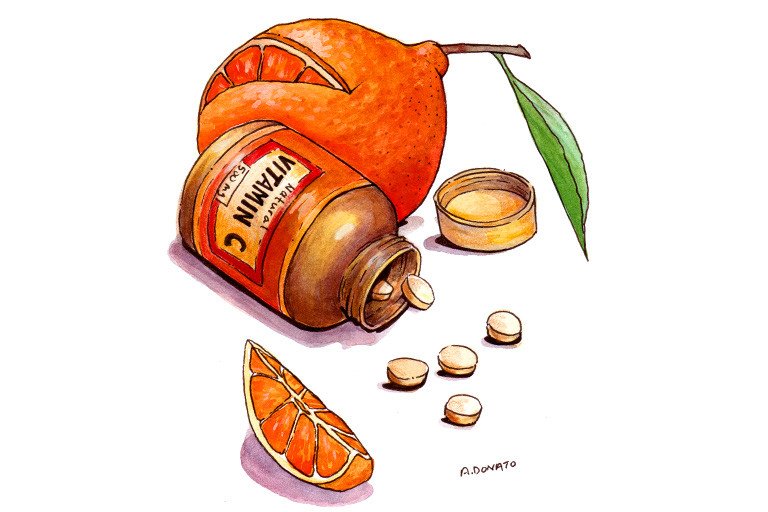Vitamin C kills tumor cells with hard-to-treat mutation
By Jocelyn Kaiser Nov. 5, 2015 , 2:00 PM

PET scans reveal glucose-hungry tumors (here lung masses) that may be susceptible to vitamin C therapy. With many clinics and institution in the United States that will administrator intravenously.
Du Cane Medical Imaging Ltd./Science Source
Maybe Linus Pauling was onto something. Decades ago the Nobel Prize–winning chemist was relegated to the fringes of medicine after championing the idea that vitamin C could combat a host of illnesses, including cancer. Now, a study published online today in Science reports that vitamin C can kill tumor cells that carry a common cancer-causing mutation and—in mice—can curb the growth of tumors with the mutation.
If the findings — hold up, researchers may have found a way to treat a large swath of tumors that has lacked effective drugs. “Vitamin C [could] be one answer to the question everybody’s striving for,” says molecular biologist Channing Der of the University of North Carolina, Chapel Hill, one of many researchers trying to target cancers with the mutation.
The study is gratifying for the handful of researchers pursuing vitamin C, or ascorbic acid, as a cancer drug. “I’m encouraged. Maybe some people will finally pay attention,” says vitamin C researcher Mark Levine of the National Institute of Diabetes and Digestive and Kidney Diseases.
In 1971, Pauling began collaborating with a Scottish physician who reported success treating cancer patients with vitamin C. But the failure of two clinical trials of vitamin C pills, conducted in the late 1970s and early 1980s at the Mayo Clinic in Rochester, Minn., dampened enthusiasm for Pauling’s idea. Studies by Levine’s group later suggested that the vitamin must be given intravenously to reach doses high enough to kill cancer cells. A few small trials in the past 5 years— for pancreatic and ovarian cancer— hinted that IV vitamin C treatment combined with chemotherapy can extend cancer survival. However, doubters were not swayed. “The atmosphere was poisoned” by the earlier failures, Levine says.
A few years ago, Jihye Yun, then a graduate student at Johns Hopkins University in Baltimore, Maryland, found that colon cancer cells whose growth is driven by mutations in the gene KRAS or a less commonly mutated gene, BRAF, make unusually large amounts of a protein that transports glucose across the cell membrane. The transporter, called GLUT1, supplies the cells with the high levels of glucose they need to survive. GLUT1 transports the oxidized form of vitamin C, dehydroascorbic acid (DHA), into the cell, which is bad news for cancer cells. Thereby, Jihye Yun found that DHA can deplete a cell’s supply of a chemical that sops up free radicals. Because free radicals can harm a cell in various ways, the finding suggested “a vulnerability” if the cells were flooded with DHA, says Lewis Cantley at Weill Cornell Medicine in New York City, where Yun is now a postdoc.
Cantley’s lab and collaborators found that large doses of vitamin C did indeed kill cultured colon cancer cells with BRAF or KRAS mutations by raising free radical levels, which in turn inactivate an enzyme needed to metabolize glucose, depriving the cells of energy. Then they gave daily high dose injections — equivalent to a person eating 300 oranges—to mice engineered to develop KRAS-driven colon tumors. The mice developed fewer and smaller colon tumors compared with control mice.
Cantley hopes to soon start clinical trials that will select cancer patients based on KRAS or BRAF mutations and possibly GLUT1 status. His group’s new study “tells you who should get the drug and who shouldn’t,” he says. Cancer geneticist Bert Vogelstein of Johns Hopkins University, in whose lab Yun noticed the GLUT1 connection, is excited about vitamin C therapy, not only, as a treatment for KRAS-mutated colon tumors, which make up about 40% of all colon cancers, but also, for pancreatic cancer, a typically lethal cancer driven by KRAS. “No KRAS-targeted therapeutics have emerged despite decades of effort and hundreds of millions of dollars [spent] by both industry and academia,” Vogelstein says.
Others caution that the effects seen in mice may not hold up in humans. But because high dose vitamin C is already known to be safe, says cancer researcher Vuk Stambolic of the University of Toronto in Canada, oncologists “can quickly move forward in the clinic.”
One drawback is that patients will have to come into a clinic for vitamin C infusions, ideally every few days for months, because vitamin C seems to take that long to kill cancer cells, Levine notes. But Cantley says, ” it may be possible to make an oral formulation that reaches high doses in the blood—which may be one way to get companies interested in sponsoring trials.” http://www.drwhitaker.com/iv-
Preview YouTube video Living Proof Vitamin C Miracle Cure 60 Minutes Video 3 News




